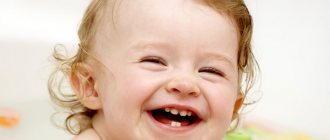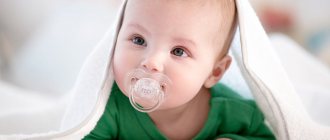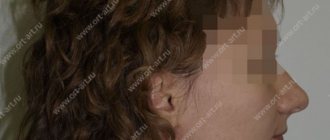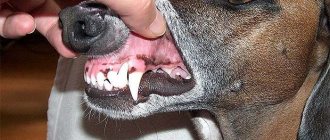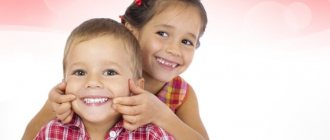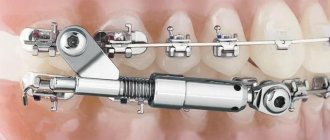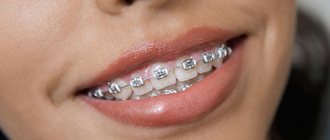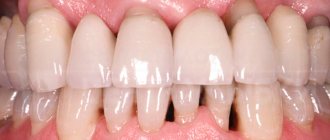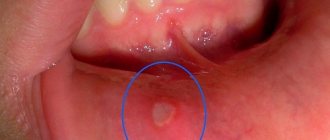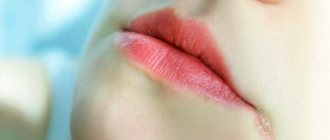Types of dental malocclusion in children
- Distal bite.
The lower jaw is posterior to the upper jaw
- Mesial bite.
Does the child have an incorrect bite, does the lower jaw protrude forward? This kind of bite is called mesial. In this poetic form, we can give a brief description of another common type of jaw disproportion, when the lower jaw is much more developed than the upper.
- Cross or scissor bite.
A less common, but very unpleasant dental anomaly. With a crossbite in a certain place, the jaws close in the opposite relationship - they close in reverse, which is why the dentition resembles scissors.
- Deep bite.
A very common type of malocclusion in children and adults, when the upper teeth cover the lower teeth by more than half.
- Open bite.
One of the most complex anomalies, causing physical and psychological discomfort to the child. The upper and lower rows of teeth cannot meet completely, causing a noticeable gap to form between them.
Above we described what a child’s malocclusion looks like in various manifestations, but we should also briefly talk about the correct one, which can be perceived as a kind of guideline. The ideal bite is considered orthognathic. It is distinguished by an absolutely even dentition without gaps, curvature or crowding, when the upper teeth cover the lower ones by one third. There are several types of correct bite, but if your child has dental defects, this almost always indicates problems.
What patients who want to correct their bite at 30 need to know
The patient's age cannot be a contraindication to installing braces. Bite pathology can be corrected at any age, but it is worth considering the specifics of treatment. The older the patient, the longer the process of correcting the bite using braces will be. If in adolescence this period can be a year or a year and a half, then for patients over 30 years old the brace system will have to be worn for two to three years. The reason is slow metabolic processes and a stop in the growth of bone tissue.
The patient’s age also affects the timing of the retention period - the second stage of treatment for malocclusion pathology, which is considered mandatory. At this stage, the patient wears orthodontic retainers, which are installed on the inside of the jaw arch. Their task is to fix the teeth in a new position for them. For patients under 30 years of age, this period is equal to the period of wearing braces themselves, but for patients older than this age, the period can increase by 2-3 times. There are also cases when a patient, after correcting his bite, has to use retainers for the rest of his life. To refuse the retention period means to be at risk of relapse of the pathology.
Often, in order to achieve a positive result in treatment, older patients have to undergo surgery. This is especially true in cases where there is not enough space for the tooth to take the correct position in the jaw arch. The jaw bone no longer grows and this area is unlikely to form on its own. Then one of the incorrectly positioned teeth is removed, freeing up space so that other teeth can take the correct position. An orthodontist’s refusal to install braces after 30 years of age can only serve as a contraindication.
How to determine malocclusion in a child?
“How can you tell if a child has a malocclusion?” - This is a question many parents ask. It is important to understand that only an experienced pediatric orthodontist can make an accurate diagnosis here, so we strongly advise you to undergo regular preventive examinations with this specialist from a very early age until the complete replacement of baby teeth with molars. If the baby teeth are located too closely together, this can also become an additional complication when the molars erupt (the latter take up more space because they are larger). In the case of a small child (under 3 years old), it is difficult to be guided by purely visual principles and determine by eye whether the bite is correct or incorrect. Be that as it may, there are a number of signs that directly or indirectly indicate that the child has prerequisites for orthodontic anomalies.
Improper breathing
The child's mouth is constantly in a half-open position, he does not breathe through his nose (of course, if there are no colds).
Snore
If your baby constantly snores in his sleep, this may also be one of the consequences of the development of malocclusion.
Jaw formation
Pay attention to how the child's jaws are formed. Ideally, there should be no noticeable disproportion between the top and bottom. Additionally, if a child continually pushes their lower jaw forward, this is considered a clear sign of pediatric bite problems.
Postural disorders
If your child has postural and spinal problems, this may affect the development of malocclusions.
Optimal patient age for installation of braces
The most effective period for correcting malocclusion is considered to be the age of the patient from 12 to 25 years. This is the period when the formation of a permanent bite occurs. The jaw arch is actively developing. The baby teeth were completely replaced by permanent incisors and molars. The third permanent molars are erupting. The use of a brace system during this period gives the most effective result, which can be achieved in a short time.
Having crossed this age limit, many processes of the formation of the dentofacial system are suspended, but the mesial movement of the teeth continues. This movement depends on the process of abrasion of the contact surface of the teeth, and therefore continues throughout life. This feature of the dental system makes it possible to correct bite pathologies in older people. Braces can be installed at age 30, 40, or 50, but it will take longer to achieve positive results. This is due to a slow metabolic process and a halt in the growth of bone tissue.
Modern orthodontics successfully installs braces in patients over 30 years of age. Until the age of fifty, no special problems arise. The main thing is that there are no contraindications. There are cases when a person undergoes this procedure even at the age of 60. Then the decisive factors may be: the presence of calcium in the body, the condition of the jaw cavity and how sensitive the person is to anesthetic drugs.
Causes of malocclusion in children
The causes of malocclusion in children can vary, and most of them are difficult to address without orthodontic treatment. Below you can see a list of the key reasons for the occurrence of such anomalies in a child.
Genetics.
If you are wondering why your child has an incorrect bite, look at yourself first. Genetic predisposition is the most obvious and common cause of malocclusion in a child. If one or both parents have pronounced anomalies, then with a very high degree of probability their children will inherit them.
Bad habits.
Children often chew and put into their mouths literally everything they can get their hands on. Often such cravings provoke a violation of the formation and development of teeth. Malocclusion in a child from a pacifier is also quite common.
Breathing problems.
Children with nasal breathing disorders are much more likely to suffer from malocclusion, as experts say.
Problems with the musculoskeletal system.
The spine is the main “bearing structure” of our body, so it is not surprising that the functioning of the musculoskeletal system affects the dental system.
Other diseases.
The risk group (meaning malocclusion) also includes children with diabetes mellitus and central nervous system diseases.
Causes of the anomaly
The most common causes of malocclusion include disturbances in the eruption of crowns and the growth of the jaw bones. Genetic factors, concomitant diseases and habits also have a huge impact:
- Malocclusion can develop against the background of chronic diseases of the ENT organs. If a baby has impaired nasal breathing, he has to open his mouth slightly, and as a result, pathology develops.
- Parents should pay attention to the bad habits of their child; he may constantly bite his lips or tongue, suck his fingers or stick his jaw forward. The baby must be weaned off the pacifier as early as possible, otherwise his front teeth will not erupt correctly.
- Sometimes improper formation of the dental system develops in the fetus while still in the womb. The reason for this may be various pathological conditions of a woman during pregnancy. Anemia, viral diseases and other factors can contribute to developmental disorders in the baby.
- Etiological factors play an equally important role in the formation of malocclusion in a child. The child may receive a birth injury, his temporary teeth may not be removed in time or destroyed by caries.
- Poor nutrition and mineral deficiency negatively affect the condition of bone tissue. Adults encounter a similar problem only in rare cases when dental implantation or orthopedic treatment was performed incorrectly.
Treatment of malocclusion in children
What to do if a child has an incorrect bite? Of course, start treatment immediately! Unlike adults, where malocclusions can only be corrected with braces or aligners (and in severe cases, surgery is often necessary), malocclusions in children are treated in a variety of ways. The technique depends on the age of the child and the specific clinical case. Below is a table showing possible treatment technologies for children of different age groups.
Malocclusion in a child under one year old
For very young children (up to 1 year), it is important to choose special orthodontic nipples for feeding, and also try to refuse pacifiers, which can negatively affect the development of teeth.
Malocclusion in a child aged 1–2 years
At this age, milk teeth begin to actively erupt, so the baby can already be taken to the orthodontist. When there is a potential malocclusion in a one-year-old child, special dental guards are often required to reduce the likelihood of developing malocclusions due to chewing habits.
Malocclusion in a child from 3 to 7 years old
By age 3, a child's primary teeth will usually have fully erupted, so correction of orthodontic problems can begin if necessary. At this age, to correct the bite, removable plates, trainers and LM activators are usually used, which are designed to straighten, expand or narrow the dentition, as well as improve diction.
Malocclusion in a child 8–9 years old
8 - 9 years are considered the borderline age when active replacement of primary teeth with molars occurs. It is important here that the process goes as smoothly and successfully as possible. To correct the dentition, the same trainers and plates can be used, as well as special orthodontic devices that ensure the correct interaction of the elements of the dental system, including muscles and soft tissues.
Malocclusion in a child 10–11 years old
At the age of 10, many children have a completely new set of teeth, so this age is considered the minimum acceptable age to start wearing braces. Today in orthodontics, aligners are also widely used - removable transparent aligners for correcting malocclusion.
Alternative techniques
Mouth guards for bite correction
As an alternative to braces, the orthodontist may suggest a mouth guard to correct the bite in children over 17–18 years of age. With their help, it is possible to correct defects in the upper dentition and correct the bite on the lower jaw in children.
Myotherapy
Another alternative option for correcting malocclusion in children is myotherapy. The essence of this technique is to perform special exercises to correct the bite in children. As a result of regular training, the muscular system begins to work correctly, and the teeth are aligned. The peculiarity of this method is that it can be used both as an independent and as an additional means for correcting dental defects. It is suitable for children no older than four years old, so it is impossible to do without the supervision of an adult during the exercises.
However, myomotherapy is not suitable for every child, as it has the following contraindications:
- impaired mobility of the jaw arch;
- muscle hypertrophy;
- severe dental anomalies;
- deformation of the maxillofacial system after illness or injury.
Surgery
Surgery also applies to correcting malocclusions without braces in older children, but this method is not common and is used as a last resort. Correction of malocclusion in children under 12 years of age by surgery, as a rule, is carried out only for special indications. These include the following defects:
- congenital malformation of the jaw;
- facial asymmetry;
- chin dysplasia;
- skeletal abnormalities;
- deformation of the cranial vault.
In all other cases, the specialist will try to solve the problem in a less radical way, for example, with braces or prosthetics.
Consequences of malocclusion in a child
Unfortunately, it is still not uncommon for parents to have no idea what the dangers of malocclusion in children are and are rather irresponsible about their dental health. Over time, the child develops malocclusions that carry with him into adulthood. In childhood, teeth are much more mobile and respond well to directed mechanical influence, while correcting a bite in an adult is a much more complex and lengthy process. Moreover, adults are much less likely to agree to treatment because of the associated inconveniences and restrictions, which over time leads to a number of complications and unpleasant consequences. An incorrect bite leads to disruption of the muscles and joints of the entire dental system, which causes characteristic clicks, spasms and pains that spread to adjacent areas and lead to migraines, hearing loss and other unpleasant manifestations. Improper functioning of the temporomandibular joint, in turn, often leads to apnea (sleep breathing disorder), which is an additional factor in the occurrence of cardiovascular diseases and leads to much more tragic consequences.
Why is malocclusion dangerous in children from a psychological point of view? If a child has serious abnormalities, this will certainly affect his self-esteem (especially in adolescence and adulthood). In the modern world, a smile is perceived as an integral part of the image of a healthy and successful person, so the issue of aesthetics in this case is also very important. As you can see, everything in our body is interconnected, so do not put off orthodontic treatment under any circumstances, especially since in childhood any problem is corrected easier and faster.
Symptoms
There are obvious signs of dental malocclusion that are noticeable even to a person without medical education.
- Curvature and rotation along the axis of the teeth.
- Excessive protrusion of the lower jaw forward or, conversely, predominance of the size of the upper jaw.
- The presence of a gap between the central incisors.
- The location of the canines outside the dental arch.
- Crowding of teeth, especially common in the anterior part of the lower jaw.
- Excessive overlap of the lower incisors by the upper ones.
- Reverse jaw position.
In addition to aesthetic defects, with dental anomalies, children may complain that it is difficult for them to chew and swallow food. Also, sometimes the child is worried about the constant injury to the soft tissues of the oral cavity from the sharp edges of the teeth, as well as difficult nasal breathing and, as a result, a forced open position of the mouth, which causes the mucous membranes to dry out. Often, an incorrect bite, even in a small child who is 2 or 3 years old, causes pain in the facial and chewing muscles, as well as attacks of headaches.
Upon careful examination, you will notice that in such children the nasolabial folds are often tense, mouth breathing predominates, and there is tension in the chin area and lips during the process of swallowing food. There are also often some changes in the profile, slight asymmetry of the face.
However, the main problems with incorrect jaw position lie deep inside. Due to the fact that the lower jaw protrudes forward or backward, its position relative to the base of the skull and spinal column is shifted. This, in turn, leads to poor posture, pinched nerve endings and headaches. Very often, in children with pathologies of the dentofacial apparatus, doctors note dyslalia - a violation of the pronunciation of certain sounds.
Directly in the oral cavity, an abnormal bite leads to mechanical injuries to the cheeks and tongue due to biting by the cusps of the teeth. Also, many children experience hypersensitivity due to increased abrasion of hard tissues, bleeding gums, gingivitis, periodontitis and diseases affecting the temporomandibular joint.
Another important aspect of pathological occlusion is the psychological discomfort that occurs in a child due to the fact that he is slightly different in appearance from other children. It is especially aggravated if the child hears ridicule from his peers. This leads to isolation, irritability and the development of complexes.
